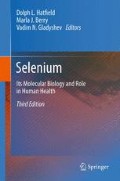Abstract
Evolutionary adaptations to dietary selenium may explain the use of selenocysteine in proteins. If so, adaptive signals should be present in the genomic regions of selenoprotein genes. It is, however, difficult to identify the signatures of adaptation left by natural selection in the genome of extant species (including humans). Furthermore, dietary adaptations to selenium may have happened in some species but not in others. For example, while dietary selenium does not seem to be a major selective force behind the evolution of selenocysteine use in vertebrate proteins, it may be an important factor in other lineages. Whether levels of selenium in the diet have driven the evolution of other functionally important amino acid changes in selenoproteins is not known. Dietary selenium may have also shaped the regulation of selenoprotein genes and of genes involved in the metabolism of selenium. Evolutionary genetics methods aimed at detecting signals of natural selection at the regulatory level are key to answering this question. Understanding the genetic basis of adaptations to levels of selenium in the diet would help shed light on the molecular mechanisms behind the metabolism of selenium.
Access this chapter
Tax calculation will be finalised at checkout
Purchases are for personal use only
References
Kryukov GV, Castellano S, Novoselov SV et al (2003) Science 300:1439
Kryukov GV, Gladyshev VN (2004) EMBO Rep 5:538
Castellano S, Lobanov AV, Chapple C et al (2005) Proc Natl Acad Sci USA 102:16188
Fomenko DE, Xing W, Adair BM et al (2007) Science 315:387
Castellano S, Andrés AM, Bosch E et al (2009) Mol Biol Evol 26:2031
Distante S, Robson KJH, Graham-Campbell J et al (2004) Hum Genet 115:269
Denic S, Agarwal MM (2007) Nutrition 23:603
Levander OA (1987) Ann Rev Nutr 7:227
Valentine JL (1997) Biomed Environ Sci 10:292
Steinnes E (2009) Environ Geochem Health 31:523
Luca F, Perry GH, Di Rienzo A (2010) Annu Rev Nutr 30:291
Castellano S (2009) Biochim Biophys Acta 1790:1463
Hartl DL, Clark AG (2007) Principles of population genetics, 4th edn. Sinauer Associates, Sunderland
Kimura M (1968) Nature 217:624
Kanzok SM, Fechner A, Bauer H et al (2001) Science 291:643
Gromer S, Johansson L, Bauer H et al (2003) Proc Natl Acad Sci USA 100:12618
Kim HY, Gladyshev VN (2005) PLoS Biol 3:e375
Weiss G (2002) Eur J Clin Invest 32:70
Chua ACG, Graham RM, Trinder D et al (2007) Crit Rev Clin Lab Sci 44:413
Datz C, Haas T, Rinner H et al (1998) Clin Chem 44:2429
Beutler E (2006) Annu Rev Med 57:331
Merryweatherclarke AT, Pointon JJ, Shearman JD et al (1997) J Med Genet 34:275
Stephens JC, Reich DE, Goldstein DB et al (1998) Am J Hum Genet 62:1507
Merryweatherclarke AT, Pointon JJ, Jouanolle AM et al (2000) Genet Test 4:183
Naugler C (2008) Med Hypotheses 70:691
Aranda N, Viteri FE, Montserrat C et al (2010) Ann Hematol 89:767
Swallow DM (2003) Annu Rev Genet 37:197
Foster CB, Aswath K, Chanock SJ et al (2006) BMC Genet 7:56
Green RE, Krause J, Briggs AW et al (2010) Science 328:710
Jeong JY, Wang Y, Sytkowski AJ (2009) Biochem Biophys Res Commun 379:583
Fang W, Goldberg ML, Pohl NM et al (2010) Carcinogenesis 31:1360
Voight BF, Kudaravalli S, Wen X et al (2006) PLoS Biol 4:446
Olds LC, Sibley E (2003) Hum Mol Genet 12:2333
Haygood R, Fedrigo O, Hanson B et al (2007) Nat Genet 39:1140
Pennington JA, Young BE (1991) J Am Diet Assoc 91:179
Müller C, Wingler K, Brigelius-Flohé R (2003) Biol Chem 384:11
Acknowledgement
This work was supported by the Max Planck Society.
Author information
Authors and Affiliations
Corresponding author
Editor information
Editors and Affiliations
Rights and permissions
Copyright information
© 2011 Springer Science+Business Media, LLC
About this chapter
Cite this chapter
White, L., Castellano, S. (2011). Evolutionary Basis for the Use of Selenocysteine. In: Hatfield, D., Berry, M., Gladyshev, V. (eds) Selenium. Springer, New York, NY. https://doi.org/10.1007/978-1-4614-1025-6_7
Download citation
DOI: https://doi.org/10.1007/978-1-4614-1025-6_7
Published:
Publisher Name: Springer, New York, NY
Print ISBN: 978-1-4614-1024-9
Online ISBN: 978-1-4614-1025-6
eBook Packages: Biomedical and Life SciencesBiomedical and Life Sciences (R0)

